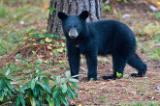 © Steve Vaughn/Panoramic Images (Florida Title Image Large)
© Steve Vaughn/Panoramic Images (Florida Title Image Large)

Florida Wildlife Action Plan
By the Association of Fish and Wildlife Agencies
Florida’s Wildlife Legacy Initiative is a comprehensive program developed by the Florida Fish and Wildlife Conservation Commission to address the conservation needs of all wildlife in Florida. The mission of the Initiative is to work together to sustain Florida’s diverse array of native wildlife and their habitats for future generations through implementing Florida’s Wildlife Action Plan, developing partnerships, and using funding sources effectively.
Florida’s Wildlife Action Plan provides a strategic framework to support the state’s native wildlife and natural habitats. The action plan identifies 974 animals and the actions needed to conserve them. A habitat-based approach categorizes the state into freshwater, saltwater, and land systems consisting of forty-five habitat categories. The plan recognizes that Florida is an interwoven system of habitats, and that wildlife moves freely across the landscape with most species dependent on a mix of habitats. By sustaining the health and integrity of these habitats, the broad array of wildlife and natural places within them are preserved for the enjoyment of future generations.
Primary Challenges to Conserving Wildlife in Florida
Florida’s action plan identifies many threats that cross multiple habitats. Five of these threats ranked as high statewide priorities.
Habitat loss
This threat is directly related to human development and activities, for example roads and cars, shopping centers, and houses. Habitat loss and fragmentation isolate wildlife and can prevent them from locating food, water, shelter and mates. As the human population increases, more land will be developed with the highest pressure occurring on coastal and upland habitats.
Loss of water resources
This threat stems from groundwater withdrawal, drainage of wetlands, and inadequate stormwater management. Many of Florida’s springs have declining water quality and reduced water flow. Contamination by fertilizers and harmful chemicals can degrade water systems to the point that they no longer support wildlife and are harmful to humans. Increased salt levels are another source of decline in water quality.
Fire management
Many of Florida’s habitats are fire-maintained systems, and many animals and plants depend on periodic fires to maintain healthy habitat conditions. Lack of fire is a threat in many upland habitats and can result in reduced availability of flowers, fruits, seeds and other foods for wildlife. Fire hazards increase when fire frequency and timing are altered, as well as when fire management does not keep pace with the accumulation of fuels. Consequently, when fire does occur it can be severe, resulting in loss of natural places for wildlife to live and threats to human health and safety.
Exotic plants and animals
Florida’s mild climate contributes to the establishment of many species of exotic plants, mammals, fish, amphibians and reptiles. Exotic marine species also are introduced into Florida waters when large boats discharge bilge water and exchange ballast water in ports or in nearshore marine environments. While the distribution of exotic species differs regionally in Florida, the threat posed by these species occurs across all habitats. Exotic species pose direct threats to wildlife through competition, predation and transmission of disease.
Artificial structures
The overall effect of dams, seawalls and other sources of shoreline hardening, dredging, beach nourishment and impoundments also can be a threat to Florida’s water resources.
Working Together for Florida’s Wildlife
Numerous state, federal and local agencies, universities and education centers, conservation and environmental organizations, recreation groups, as well as businesses and the general public participated in questionnaires, 16 workshops, two conferences, an open house and an online virtual workshop. A Web site and email contact list of approximately 1,200 individuals’ raised awareness and participation in action plan development. A broad cross-section of stakeholders with interest or expertise in Florida’s natural resources contributed over 5,000 comments on two draft plans.
The Wildlife Action Plan is one major component of Florida’s Wildlife Legacy Initiative. The Initiative seeks to conserve our native wildlife and habitats through measures emphasizing non-regulatory, voluntary, and incentive-based actions designed to create partnerships. Reaching the goals of the Initiative is an ambitious undertaking that will involve the efforts and energies of numerous individuals, groups, and agencies. Commission staff is dedicated to playing a leading role in these efforts and is committed to making the Initiative a success.
The Association of Fish and Wildlife Agencies represents all of North America’s fish and wildlife agencies, promotes sound management and conservation, and speaks with a unified voice on important fish and wildlife issues.





